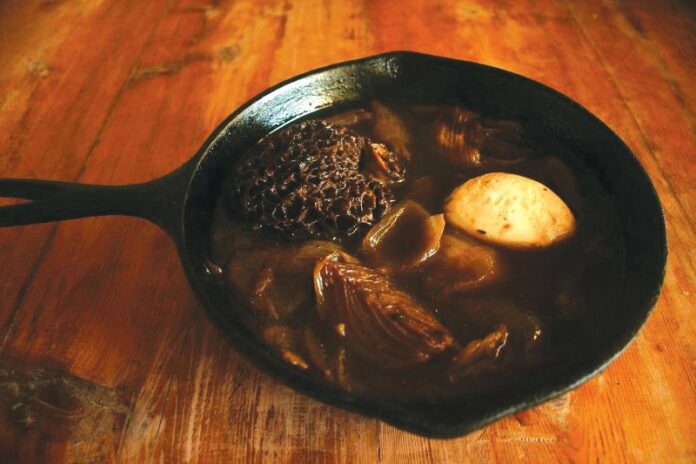French onion soup is the last meal Julia Child ate before she died. Though she once stated that she wished to go out after a gluttonous feast of caviar, oysters and foie gras, ending as she did was fitting for the champion of French cuisine. You can’t get more bucolic than onion soup.
Onions are in season right now, but few cooks are squealing for them like they do for divas like tomatoes and corn. Onions are typically supporting cast members, rarely the stars of the show, and few dishes are built around them. Nonetheless, onions are among the most essential supporting ingredients of all, right up there with oil, salt and pepper.
Add white wine to that short list of essentials, and you have the ingredients for French onion soup, one of the only dishes I know that showcases the lowly onion.
Legend has it that King Louis XV invented the soup after arriving at a hunting cabin and finding only onions, wine and butter in the cupboard. Truth be told, the average peasant’s larder would have been stocked with such ingredients as well. The creation of French onion soup was inevitable, and it was probably invented more than once.
To this day, French onion soup is the rare recipe that usually won’t require a trip to the store, because most of us have the ingredients at home. The rich, concentrated flavor and warmth of onion soup is especially appealing as chilly weather settles in. And autumn is a sad time, when it feels OK to cry.
But excessive crying over French onion soup isn’t necessary, according to Alain Ducasse, who lists among his many restaurants the Louis XV in Monte Carlo. Ducasse says keeping one’s knife sharp will reduce the number of tears shed when making French onion soup, as less of the onion’s volatile and tear-jerking cellular fluids are released with the clean, smooth cut of a sharp blade.
The impact of a sharp knife would be duly felt if following Ducasse’s recipe, which involves thin-slicing the onions—and not so much if you follow the method put forward by Nigel Slater, an Englishman no less, in his recipe, “Onion Soup Without Tears,” which appeared in his 2005 book The Kitchen Diaries. Slater’s onions are simply cut in half, once, and slowly caramelized in the oven.
Slater advises to bake the onions cut-side-down in a pan with two tablespoons of butter and a little salt and pepper. I bake the onions at 400 degrees for about 20 minutes, and then reduce the oven temperature to 200 degrees. Stir gently, on occasion, until the onions are, as Slater describes, “tender and soft, and toasted dark brown here and there.” Deglaze with shots of white wine or water whenever the pan gets dry.
Cut the onion halves into thirds, along the tip-to-root axis. To this, add a cup of white wine and bring to boil. Once there, lower the heat to a simmer and let the wine reduce into a thickening sauce. Before it starts to burn, add six cups of stock from the bones of a red-meat animal; use mushroom stock if you’re a vegetarian.
Finally, bring the soup to a boil and simmer for about 20 minutes.
Though generally served under a floating cap of melted cheesy bread, here I leave Slater and return to Julia, who liked to serve French onion soup old-school style, with a poached egg on top.
There are so many variations on the simple combination of wine, onions and butter, you could spend the rest of your life improvising. Which method you choose on any given day depends on how you’re feeling, how sharp your knife is and how attached you are to your tears.











